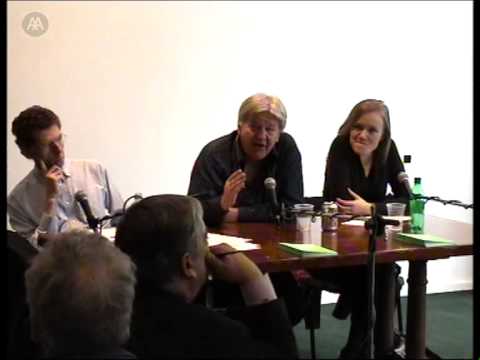
Lecture date: 2004-10-29
How can the AAs constitution be made more accessible and effective? What principles should govern any changes that the AA might make?
Sam Ashenden is senior lecturer in the Department of Politics and Sociology at Birkbeck College and a member of the London Consortium teaching faculty.
Mark Cousins is Director of General Studies and of the Graduate School Histories & Theories programme at the AA. He is a founder member of the London Consortium.
Hugo Hinsley is an architect with experience in housing, community buildings and urban development projects. He is a tutor in the Graduate School Housing and Urbanism programme at the AA and currently a member of the Interim Management Group.
Lecture transcription with Q/A:
MARK COUSINS: It’s very strange how it happens at the AA that events seem to institutionalize themselves, I noticed that people are already seating in the same seats. We want to discuss and debate about the nature of the Constitution. This bizarre object, that everyone knows we have one, but nobody knows where it is, or what it is. I think it’s widely accepted by the school is that whatever else we do, we must put the constitution on a kind of firm, clear footing, so that everyone is confident that they know what it is. It’s only fair that any incoming chair is confronted with a sort of done deal about the constitution, and the chair’s relation to it. I’m also aware that if this meeting is going to have tangible outcome, in terms of writing the constitution, this meeting will only begin to open the question and scratch the surface of the problem. Hugo and I had a brief discussion about this: when this meeting ends, it’s not the end of it. If people could send Hugo comments, observations, proposals, about the constitution as a whole or about some aspect of it, then we can begin to gether those things together and try to present some kind of more adequate document for the school and perhaps working parties, etc. This meeting begins to open the question, to which a lot more work will have to be devoted to. Obviously, you know Hugo, I’d like to introduce Sam Ashenden, from Birkbeck. Sam was a wonderful student of Paul Hirst, who taught here and tragically died last year. She followed all paul’s arguments about the nature of constitutions, in particular, in respect to participatory democracy. We thought it could be a good idea to start this meeting having someone from outside, who is concerned with what you might call political theory of participatory democracy, to give us a broad indication of the nature of participatory democracy and its founding principles.
SAM ASHENDEN: Thank you. What I’d like to do very briefly is to outline something my understanding of the importance of the Architectural Association, and then give you some brief pointers to the way in which Paul in particular though of associative models of democratic governance, which mirror quite closely some of the best features of the AA model. The Architectural Association is a self-governing institution, it inspires all, and also envy, from across the road, there, the University of London. What does it mean to be a self-governing independent institution? To me, someone that has wrote within the University of London for a decade, that means not entertaining a division between staff and students that one finds in conventional universities, increasingly enforced by things like the RAE (research assessment exercise), quality assurance mechanisms, those things which have bureaucratized higher education across this country.
That division between students and staff is not borne out particularly well at Birkbeck, luckily, because we have mature students who have to get out of the institution all they can and prepare to put it back into it. What it does, in the worse case scenario is create a sense in which things are ‘as they have to be’ and will persist, because ‘this is the way they are’. In other words, it creates a sense in which disciplines become closed upon themselves, and the infrastructure of departments, and the funding of companies creates a kind of conflict between one department and another within an institution, it makes work across conventional academic boundaries very difficult to achieve and sustain. I know this is someone who runs a multidisciplinary degree. The AA, on the other hand, by being grounded in a participatory model of democratic governance, enables all who are present within the institution to have voice in it, an equal voice in the discussion as to the functioning of the institution. That in turn, prevents an unhelpful division between those who lead and those who are led, and after all, if this institution, and other institutions of higher education are about anything, they ought to be ab